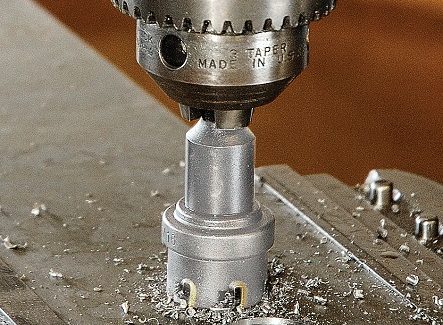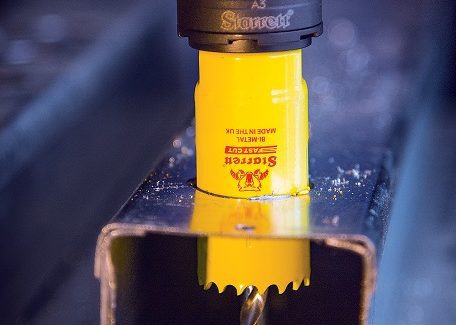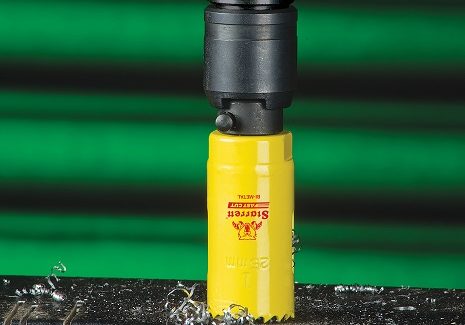Tips for Successful Hole Sawing
Hole sawing may seem straight forward, and it can be. But for optimal results, following some tips and guidelines for selecting and using hole saws is recommended. In fact, fabricators who are adept and knowledgeable about band sawing can apply some of these same strategies when hole sawing.
Posted: January 2, 2019
Hole sawing is a trepanning operation in which a core of material remains in the saw after the cut, instead of a large volume of chips accumulating around it. The core is dislodged by hand through the cleanout holes in the saw body. For time savings and convenience, an ejector spring, available as an accessory, may be placed over the pilot drill which projects slightly from the center of the hole saw. This spring compresses during the cut and releases after the cut to force out the core. In metal fabrication, it is most common to use hole saws on drill presses, radial drills, boring mills and lathes. Applications may include auto body, industrial, construction and HVAC, to name a few. Hole saws can cut clean, round holes in many machinable materials, including steel, cast iron, brass, bronze, aluminum, plastics and composites. A hardened high-speed steel cutting edge welded to a tough alloy steel back slices through the hardest-to-cut materials, absorbing mechanical shocks without shattering ‒ even when the teeth emerge through the material at the end of the cut. This type of bonded construction saves on production cost by enabling uninterrupted production and promotes safer operation.
APPLICATION SPECIFIC
There are several considerations for selecting the right hole saw and using the best set-up parameters for a specific application. Our new web-based Hole Saw PowerCalc program is an invaluable tool for making these determinations: the software recommends whether a bi-metal, carbide tipped, diamond grit or arbored hole saw is best suited for an application, as well as whether cooling is recommended. Input parameters include specifying the material to be cut, the hole diameter and material thickness. Printable results also provide a recommendation for the proper operating speeds and power tool or saw machine to use, and indicate the Starrett hole saw item number with a link to the product. In addition to using this online program for recommended selections and usage, here are some other general considerations:
OPERATING SPEED
Due to varying cutting conditions and types of material, speeds should be increased or decreased according to experience, “feel” and by following recommendations from an online calculator program or from the manufacturer. Care must be exercised especially when using hole saws in portable tools to keep the rpm within range of recommended speeds. It is absolutely possible to damage these saws by running them too fast! When the operating speed is too high, the teeth are not able to cut the material and end up just running over the workpiece material without cutting. This results in excessive heat build-up that can damage the bond between the high speed steel teeth and the cup. Recently a user cutting holes in an I-beam frame of a trailer reported that the teeth were breaking off of their bi-metal hole saws. Upon receiving the damaged saws, it was clear that the operating speed was much too high for the application. The cutting edge was burned and the teeth were also broken off in a few places. The paint around the cutting edge had bubbled up and burned off as well. After slowing down the operating speed, the user was able to complete the cuts without damaging the hole saws.
FEED PRESSURE
For best results, feed the hole saw with steady pressure at 90 deg right angles to the workpiece. Tilting or cutting at an angle may cause the saw to bind, produce a deformed hole, or strip the teeth. Certain materials, such as high nickel stainless steel, tend to glaze in the cut. Be sure to apply enough feed pressure so the teeth will penetrate, but do not overdo it. Excessive feed is the most common cause of damaged hole saws. A hole saw’s welded edge construction is practically shatterproof, but it is possible to overfeed, crowd the gullets with chips and cause teeth to rip out.
CUTTING FLUID
For cleaner cutting action and longer hole saw life, a good grade of cutting oil should be used when sawing metals, with the exception of cast iron. This is particularly important with material thicknesses over 1/8 in. If chips are not removed from the kerf at frequent intervals, the saw grinds them to a finer, more abrasive size, and the teeth become dull. If a cutting fluid is not practical, a blast of compressed air will help evacuate chips considerably. And if holes are being made merely to lighten a piece, overlapping them provides an automatic way for chips to fall out of the gullets.
ARBORS
Always use an arbor that matches the saw diameter. For best driving grip, use the arbor with the largest size shank that will fit the chuck. And for optimum time savings, quick change arbors are an excellent option. Quick change solutions, such as our new Kwik Change arbor system, offer fast tool-free changes between different sizes and types of hole saws and pilot drills, plus a simple method of core ejection and hole enlargement. Suitable for our standard hole saw range up to 6 in (152 mm) diameter, the arbor system is a key way to increase productivity for users that frequently change saw sizes.
HOLE SAW OPTIONS
Today there are a range of hole saw options available that are designed to zero-in on meeting application requirements. For cutting stainless and mild steel sheet, as well as cutting through tubes with a wall thickness of up to 1/8 in (3 mm), the latest bi-metal hole saws combine a new tooth material with extra cobalt for enhanced heat and wear resistance with a new tooth design for smoother, faster cuts on a wide range of materials when compared to constant pitch saws. Bi-metal hole saws specifically designed for deeper holes are also available with a new tooth material with extra cobalt. These saws have a hole saw depth of 2 in (51 mm) and are ideal for cutting metal or tubes with a wall thickness of more than 1/8 in (3 mm). A new, aggressive tooth design cuts a wide range of materials for multipurpose use, also helpful when cutting through both sides of the tube.
Although a bi-metal hole saw can cut steel, consider a tungsten carbide tipped hole saw for cutting stainless and high alloy steels, non-ferrous light metals and reinforced fabrics, for a much faster speed solution than is possible with a bi-metal hole saw. The tough tungsten carbide-tipped teeth have a positive cutting angle that provides fast and efficient removal of chips and swarf, with a recommended cutting depth of ½ in (13 mm). A tungsten carbide tipped hole saw is ideal for production cutting and is particularly suitable for use in drills with limited speed control. A carbide tipped hole saw operates at a higher speed for a faster cut, preventing the saw from getting hot and wearing down. Lifespan on a carbide tipped saw is increased and a higher return on investment can be realized.









